Happy Fornacalia, everyone! Forna…what?! Okay, calm down. First things first: get your mind out of the gutter. I’m not writing about some Roman hanky-panky party… this post is about the most important Roman festival of the year, in my humble opinion: Fornacalia — the Roman festival of bread and ovens! All hail Fornax! So, who the heck is Fornax, you ask? We’ll get there. But first, let’s dig deeper on Fornacalia itself.
Fornacalia was a 10 day Roman festival held from February 7th to the 17th every year where the ovens of Rome were honoured with a grain-based offering called Mola Salsa. To explore this festival, and the ritual aspect of it, we must go back to a time before commercial bread bakeries were a mainstay in the ancient Roman civic infrastructure: first to the Monarchy; and then to the Third Macedonian War, during the Roman Republic. But first, let’s define Mola Salsa.
Mola Salsa, translated from Latin into English is as follows: Mola = Milled; Salsa = Salted. Therefore, a salted milled meal. The earliest written reference to the word is by the playwright Plautus (254 – 184 BC) in Amphitryon where he writes in reference to pleasing Jupiter: “But, woman, after getting up you ought to have invoked Jupiter with salted flour or incense today, since he’s in charge of prodigies.”
Mola Salsa was created 500 years before Plautus wrote these words by the Sabine King of Rome, Numa Pompilius (753-673 BC). Pliny (Historia Naturalis, XVIII) states that:
“Numa established worship of the gods with an offering of corn and winning their favour with a salted cake, and, according to Hemina, of roasting emmer wheat because it was more wholesome for food when roasted—though he could attain this only in one way, by establishing that emmer was not in a pure condition for a religious offering unless it had been roasted. It was also Numa who established the Feast of Ovens, the holiday when emmer is roasted”.
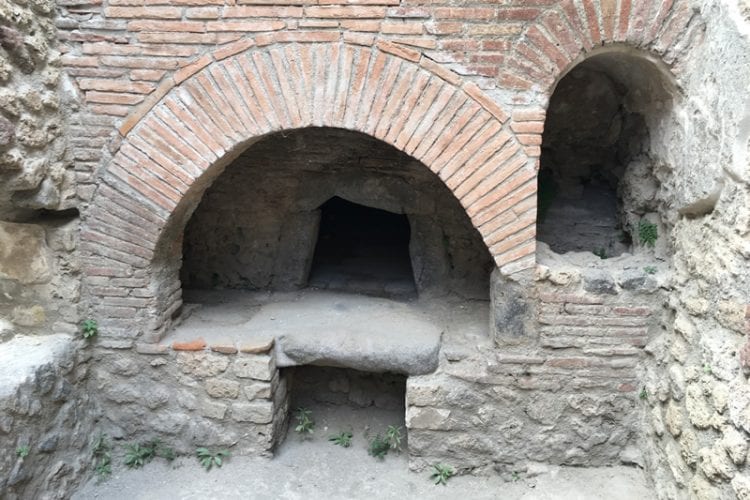
The salted cake that Pliny refers to is a Mola Salsa wafer and, in most of the ancient Roman written references, its main ingredient is roasted emmer or spelt grains, which are often misinterpreted to be one and the same species of grain. However, they are unique unto themselves, Triticum dicoccum/dicoccon and Triticum spelta L. respectively, and farro is the Italian word for spelt grain which is derived from the Latin word far. Note that corn is also a word used for grain in modern Classical academic translations of Roman writing. Pliny is not referring to maize!
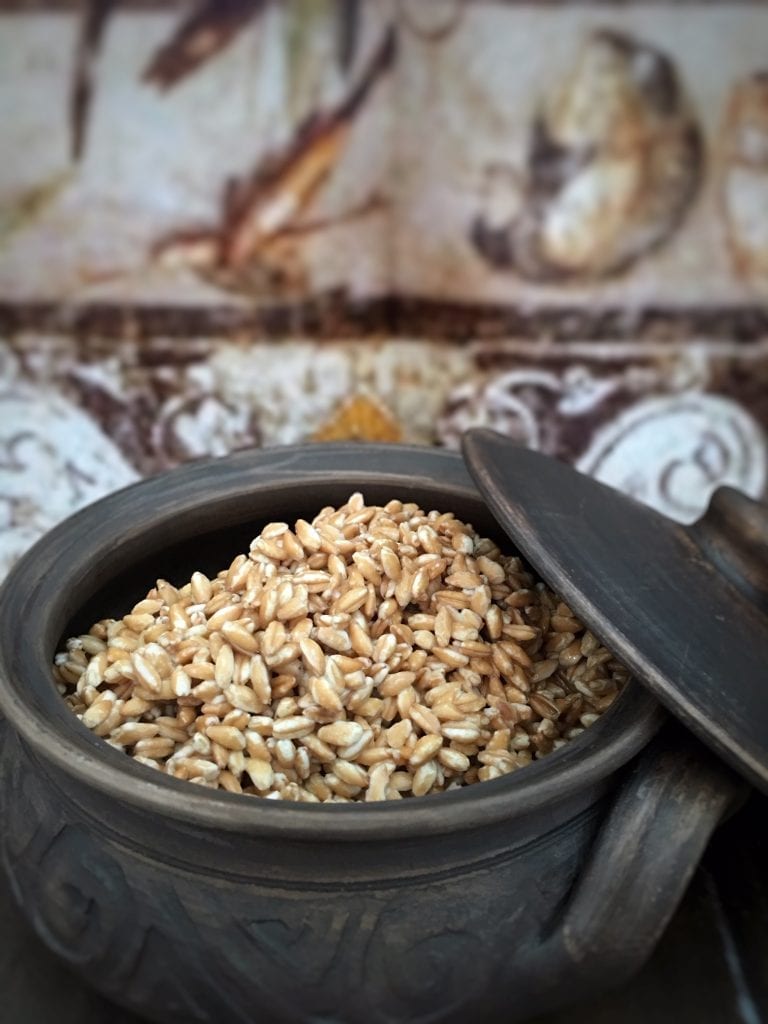
The festival that Pliny refers to above, The Feast of Ovens, was called ‘Fornacalia’ by the Romans. It was established by Numa, the second King of Rome, who was a pious king responsible for instituting many of Rome’s religious institutions and calendar reform. Ovid (Fasti, II:512) also lends a very humorous explanation as to why the festival and offering were required. He writes:
“The earth of old was tilled by men unlearned: war’s hardships wearied their active frames. More glory was to be won by the sword than by the curved plough; the neglected farm yielded its master but a small return. Yet spelt the ancients sowed, and spelt they reaped; of the cut spelt they offered the first-fruits to Ceres. Taught by experience they toasted the spelt on the fire, and many losses they incurred through their own fault. For at one time they would sweep up black ashes instead of spelt, and at another time the fire caught the huts themselves. So they made the oven into a goddess of that name (Fornax); delighted with her, the farmers prayed that she would temper the heat to the corn committed to her charge. At the present day the Prime Warden (Curio Maximus) proclaims in a set form of words the time for holding the Feast of Ovens (Fornacalia), and he celebrates the rites at no fixed date; and round about the Forum hang many tablets, on which every ward has its own particular mark.”
Ovid’s passage essentially tells us that early Romans weren’t very good farmers or grain processors! This may explain why they had their eyes set on Etruria, Sicily, Sardinia and North Africa for much of their grain supply! The Romans were certainly adept at war but perhaps they weren’t the greatest of farmers? While Ovid mentions that the Curio held the rites on no fixed date, it is commonly understood that Fornacalia was held in February as Ovid (Fasti, II:19) writes the following regarding the second month, following January:
“Our Roman fathers gave the name of februa to instruments of purification: even to this day there are many proofs that such was the meaning of the word. The pontiffs ask the King and the Flamen for woollen cloths, which in the tongue of the ancients had the name of februa. When houses are swept out, the toasted spelt and salt which the officer gets as means of cleansing are called by the same name. The same name is given to the bough, which, cut from a pure tree, wreathes with its leaves the holy brows of priests. I myself have seen the Flamen’s wife (Flaminica) begging for februa; at her request for februa a twig of pine was given her. In short, anything used to cleanse our bodies went by that name in the time of our unshorn forefathers. The month is called after these things, because the Luperci purify the whole ground with strips of hide, which are their instruments of cleansing, or because the season is pure when once peace-offerings have been made at the graves and the days devoted to the dead are past. Our sires believed that every sin and every cause of ill could be wiped out by rites or purgation. Greece set the example: she deems that the guilty can rid themselves of their crimes by being purified.”
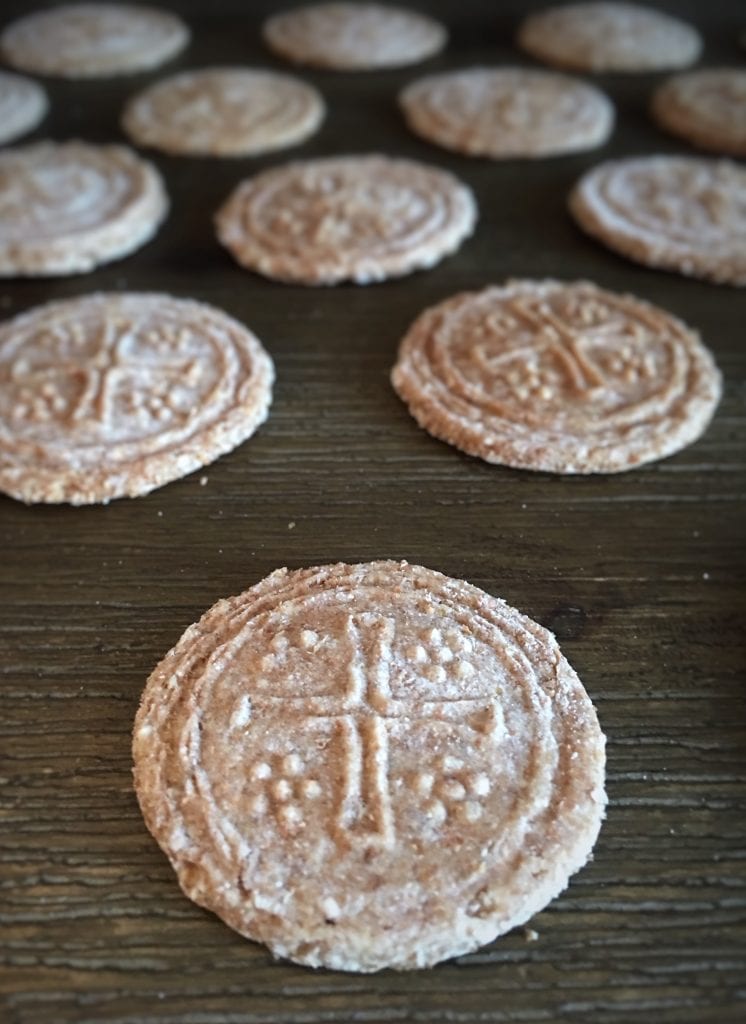
By modern academic understanding, we acknowledge that Fornacalia took place before and ended on the Quirinalia, or February 17th. This is understood as February 17th was also called the Feast of Fools (Plutarch, Moralia – The Roman Questions, 89); (Ovid, Fasti II:512) as this was the last possible day to celebrate Fornacalia for the illiterate or the lost who did not know which ward or curia they belonged to during the daily rites assigned to each ward. There were 10 curiae in Rome at the time which therefore gives us a starting date of February 7th. Fornacalia was a 10-day festival honouring Fornax and the ovens of Rome that ran from February 7th to the 17th. Note: Fornacalia is not to be confused with Vestalia, which is a festival honouring the Goddess of the hearths, Vesta, which was understood to have been held annually in June.
If we then consider the ritual past and the importance placed on grain and ovens during the Roman Monarchy, it makes perfect sense as to why this festival would have been an institution and a social mainstay in Rome by the time of the Republic. Pliny (Historia Naturalis, XVIII) writes that commercial bakeries weren’t a reality in Rome until around 173 BC, following the Third Macedonian War. Some people believe that this is due to Greek slaves introducing leavened bread starter into the bakeries of Rome but the most logical explanation is that populations were booming, Roman commerce and industry was growing, and urbanization increased in all Roman towns on the Italian peninsula. Rural pistores who once parched and milled flour in the Roman countryside moved into the urban centres and became the powerful collegia of bakers that eventually ran the many commercial bakeries that can still be seen today at Ostia Antica, Pompeii and Morgantina. By this point in Roman history, cereal grains, and bread, made up close to two thirds of the Roman daily diet and ovens were responsible for delivering these grain calories to an increasing population of Roman people. Fornacalia and the Mola Salsa was a necessity for the Romans; a rite and an offering that pleased Fornax and kept the Republic, and later the Empire, well-fed and peaceful.
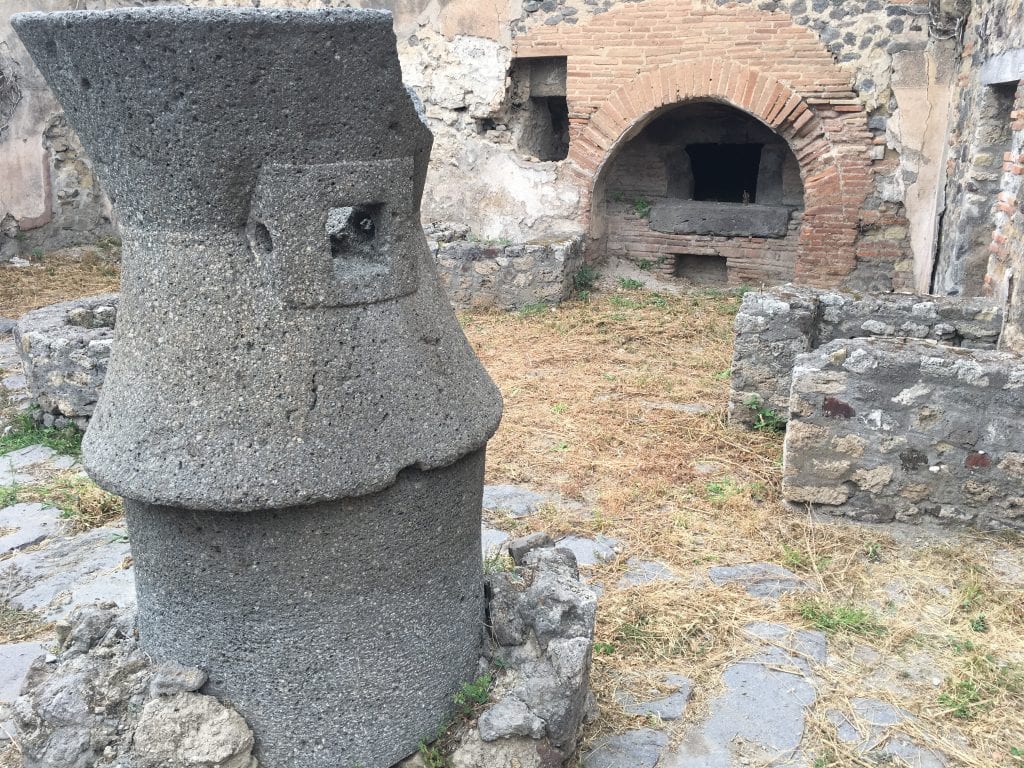
One of the most beautiful archaeological remnants of an offering of Mola Salsa can be seen on the wall of an ancient Roman bakery at Pompeii (VII 12, 11). On the wall is a lararium fresco depicting Vesta seated in front of an altar with two lares (household deities) on either side of her. On the altar in front of Vesta is a small fire burning. Considering that this fresco can be found in one of the many commercial bakeries at Pompeii, one could reasonably assume that it is Mola Salsa, salted meal, being burned in front of her on the altar; an offering meant to please her so she would keep the hearth warm and the fire burning.
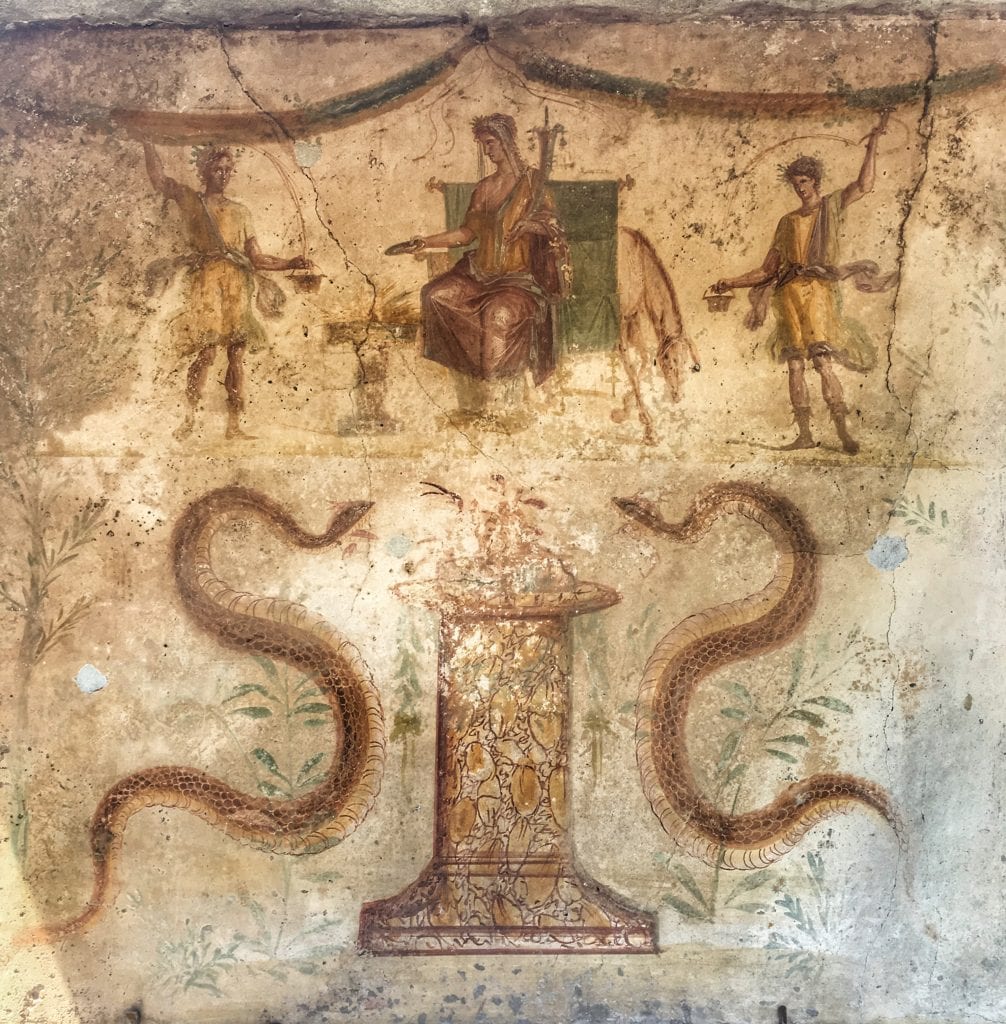
With all of that said, and in honour of this important Roman annual festival, I am now posting a simple recipe to get you into the festive spirit and to help you to find a small way to ask the Goddess of ovens, Fornax, for good bread in your home for the year to come.
Mola Salsa – How to Make It
You have two options here, but either one is authentic. You may simply make the salted meal and call it a day or you may continue by forming the meal into wafers that can be used as offerings and can also be stored for later use. I chose to make the wafers because I don’t find it very satisfying to burn flour or walk around sprinkling it all over my pets and family. I’d rather produce something lasting and pleasing to Fornax and to my own trusty ceramic outdoor oven. Plus, the wafer makes a bloody good cracker that goes beautifully with moretum, cheese and soups… Whichever option you decide to go with, the appropriate preparation directions are below. Here’s what you’re going to need:
Ingredients
- 1 lb (.45 kg) of whole-grain spelt (groats)
- 2 tsp (10 gr) of coarse, non-iodized salt
- ½ to ¾ cup of water (wafers only)
Implements
- A hand-mill or mortar or food processer
- Two to three large flat baking sheets
- 2 inch (5 cm) circular cookie cutter (wafers only)
- Corzetti stamp (optional)
- Whole wheat flour for dusting (wafers only)
- A rolling pin (Wafers only)
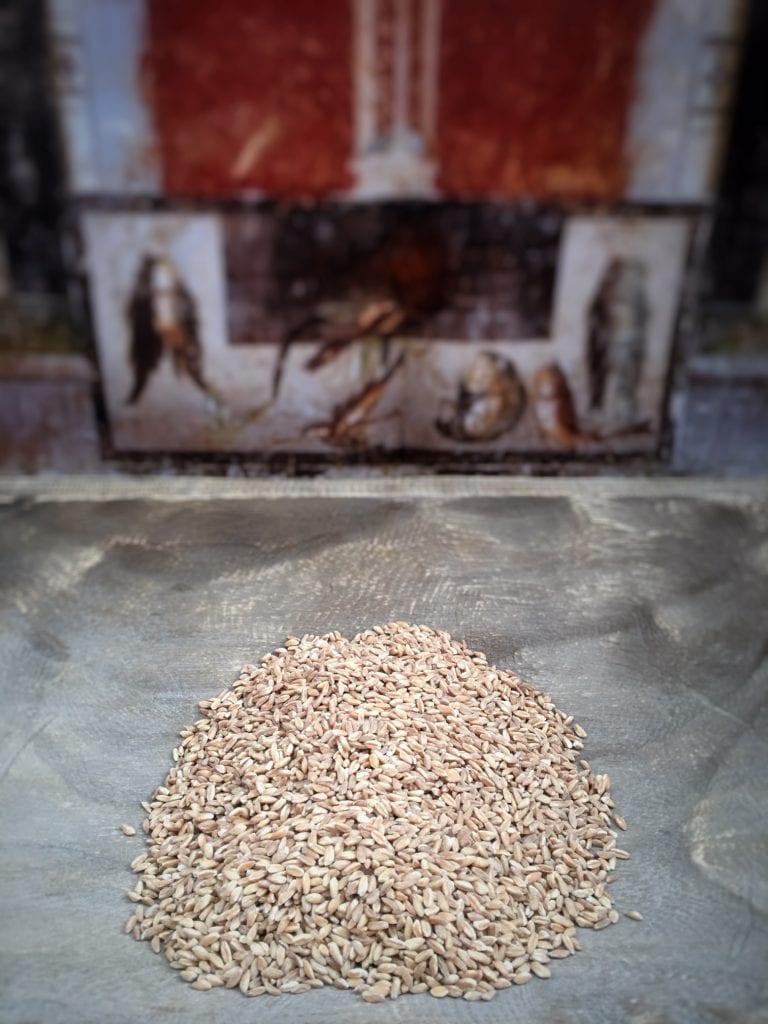
Salted Meal
1. To begin preparing the spelt for both final products, you’ll want to soak the
groats in water overnight. Put the groats into a large bowl and cover them with
at least 3 inches (8 cm) of water. 8-12 hours of soaking should suffice. This
not only washes the grain, making it clean for the offering, but it also
tenderizes them and will make it easier to mill, mulch or process them into
meal the following day.
2. Preheat your oven to 300 F / 150 C / Gas Mark 2.
3. Drain the soaked spelt grains in a colander, rinse it, and then lay the grains flat on several baking sheets. We are now going to parch the grain. Note: You may wish to keep the starch water for later use. The Romans called this amulum and they used it to thicken soups, sauces and stews.
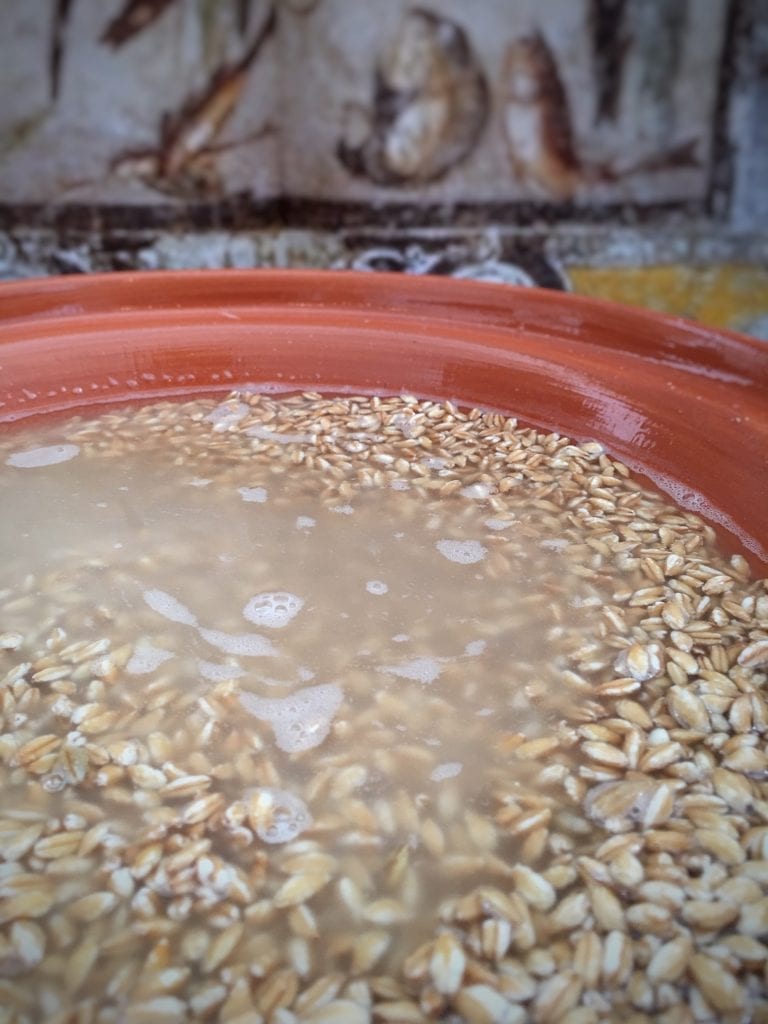
4. Parch (roast) the grain for 10 minutes in the oven. This not only rids the grain of impurities further for the offering, but it also makes the husk brittle and easier to crack when processing into meal.
5. After 10 minutes, remove the spelt from the oven and let stand. Once the parched grains have cooled, place them into your mortar, mill or food processer and pulverize the grains until they form a coarse meal. The end result will not look like modern refined white flour. Rather, it will look like a chunkier whole wheat flour once it’s complete.
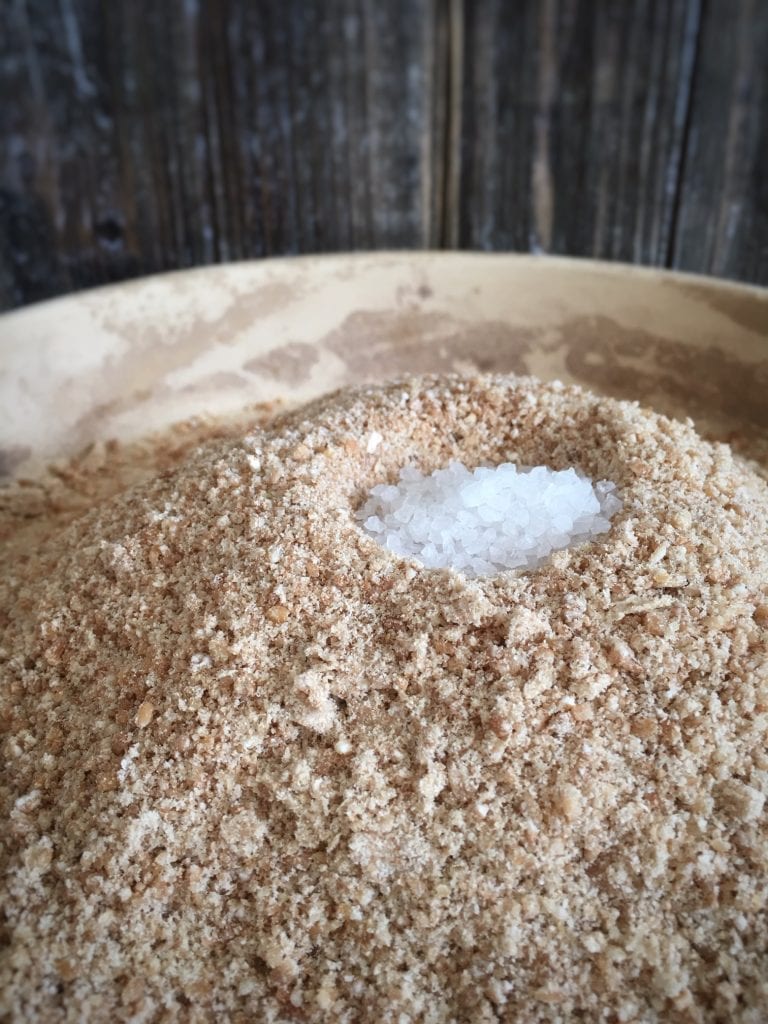
6. Place 2 tsp of coarse non-iodized salt into the meal and mix it together. You may, of course, crush or mill the salt into a finer consistency. Note: the salt must be non-iodized and coarse as it is unadulterated and closer to the original form of salt that would have been extracted from the salt flats or mines in the Mediterranean region during Classical Antiquity. You have now made salted meal! Continue below to make the wafers.
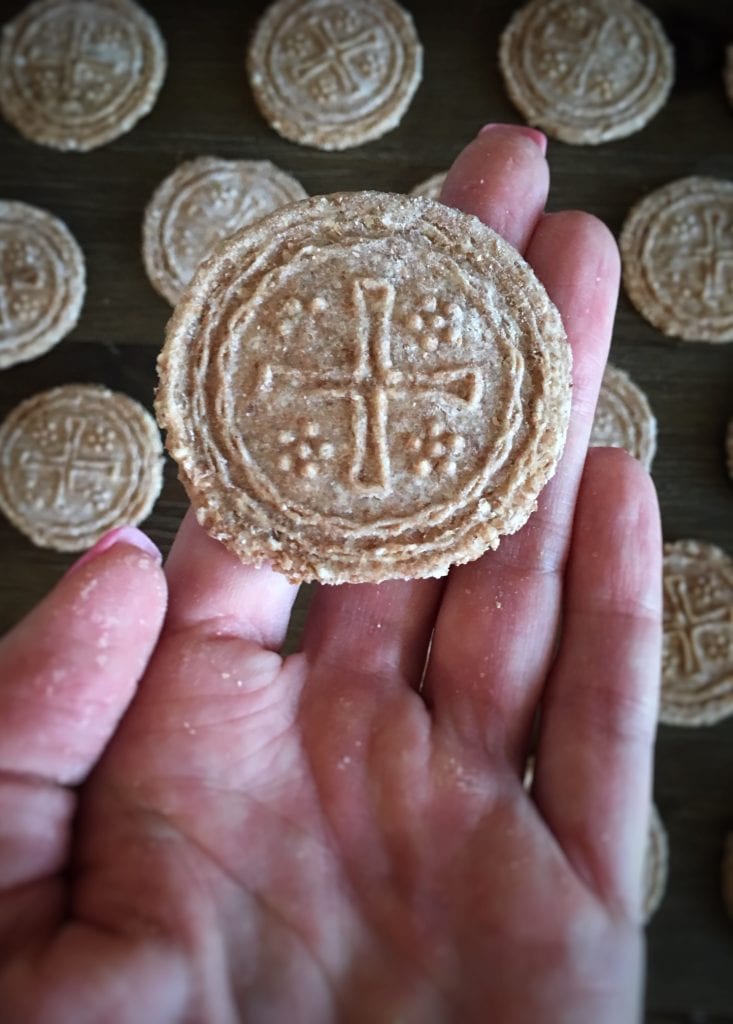
Mola Salsa Wafers
7. Increase the oven heat to 350 F / 175 C / Gas Mark 4.
8. To make the wafers, place all of the meal and salt into a large mixing bowl and slowly add the ½ to ¾ cup of water to the meal, kneading as you go. You may use a dough mixer to do this but I am not sure that Fornax would approve… Knead the dough on a cutting board until you have a firm ball of dough. Cover with a damp cotton or linen cloth and let it sit for 30 minutes to bind.
9. Dust a large cutting board with flour and place the dough onto the cutting board. Roll the dough out, in sections, until the dough is about ¼ of an inch (1/2 cm) thick.
10. Using the cookie cutter, punch out as many wafers as you can and place them onto a non-stick baking sheet or a baking sheet that has been lightly dusted with flour.
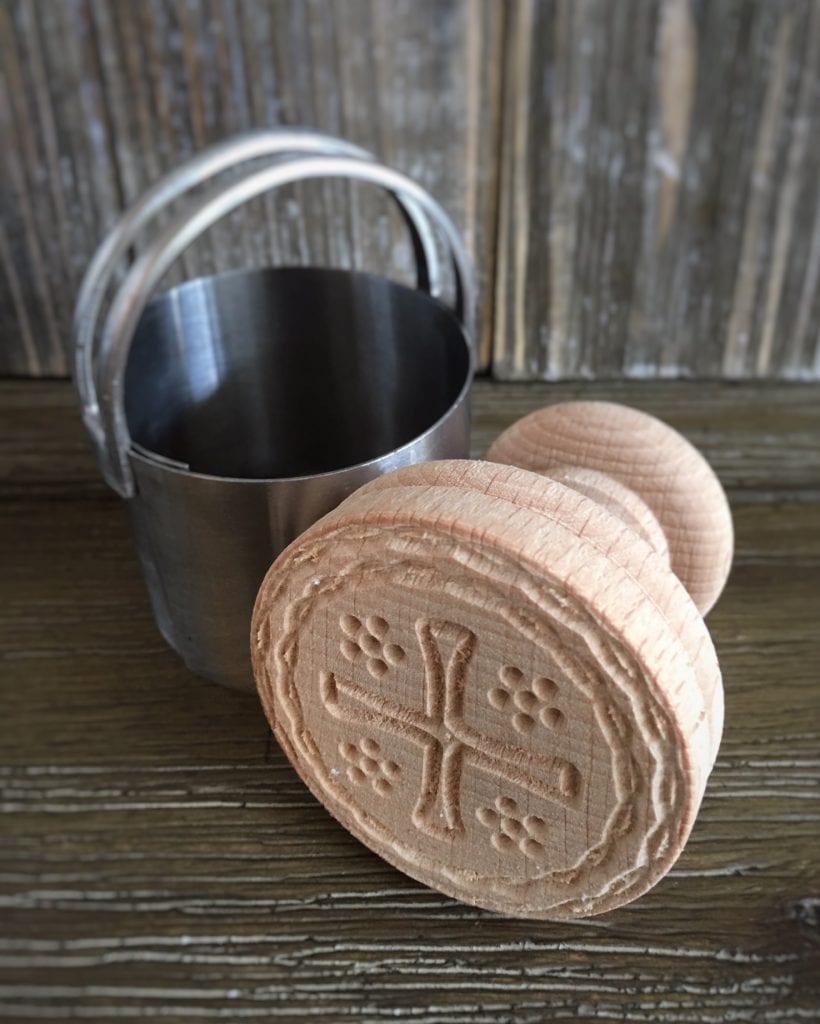
11. Optional: One the baking sheet, stamp each mola salsa wafer with an impression of your choice. I chose to use my Corzetti stamp impression as it is very similar to a symbol that I have seen stamped onto 1st century Roman breads excavated from the Bay of Naples region.
12. Place the baking sheets into the oven and bake the wafers for 20 minutes. Once done, remove them and let them cool. The wafers will harden more and become crisp as they cool.
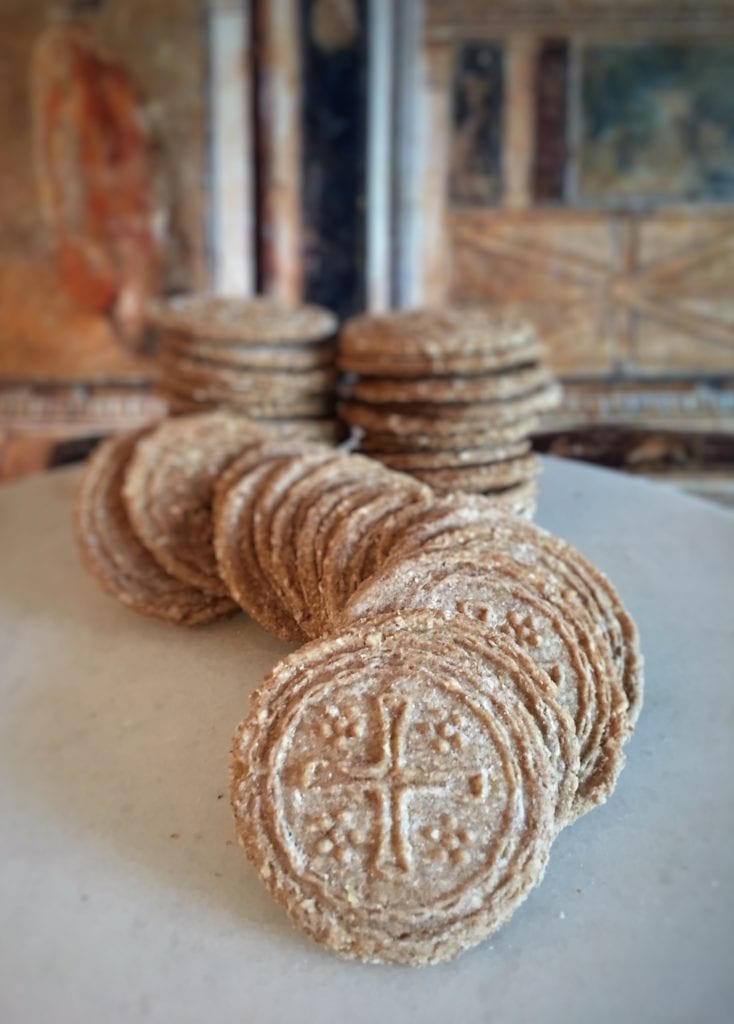
Mola Salsa – How to offer it
To offer the meal itself, burn it in an incense burner or on a makeshift altar. If you’re going to burn it, for the love of Janus, be careful. Do it using a wick in an incense burner, or in a metal container, on a surface that won’t ignite. To play it safe, you may want to simply leave the meal in a decorative bowl on your oven overnight to purify it and ensure unburnt bread (and fully cooked TV dinners) in the year to come.
If you chose to make the wafers, you can crumble them onto anything that you wish to purify be it your husband, your neighbor, or that second-hand sectional you got from your sister. Sprinkling the Mola Salsa or crumbling the wafer over the necks and heads of animals that were being prepared for sacrifice was once a part of a purification process in Roman ritual. Salt was cleansing and antiseptic and the Romans were well aware of its medicinal properties in addition to its ability to add flavor to food. Sacrifice of heifers was common in ancient Rome and salted meal was used to purify the beast before the sacrifice. Seneca (Oedipus, 335) speaks of sprinkling cattle with salted meal before a sacrifice. Horace (Satires, II:200) writes of a child being sacrificed instead of a heifer with salted meal being sprinkled on her head. What’s interesting about the Mola Salsa wafers is that when the wafer was the sacrifice itself, offered to Fornax and burned in the bread ovens, this was a non-living offering; a ‘sacrifice’ that did not end a life or spill blood. The concept of a wafer being used as a ritual food item that is both a non-living offering and a method of purification may sound familiar to some of us who are Catholic: The Holy Eucharist. The Communion wafer symbolizes the body of Christ who ‘sacrificed’ himself for everyone else’s sins and impurities so that his followers would not have to make a living offering and end a life themselves. For Catholics — who are a part of one of the key historical contributions of the Roman Empire to the modern world — the communion wafer is taken as a remembrance of Jesus Christ and his sacrifice. Receiving communion is also a symbolic gesture of commitment and purification from sin and other personal defects, just as Ovid mentioned above in reference to februa. I wonder where the Holy Roman Catholic Church got that wafer idea? I’d say that the continuity between Mola Salsa wafers and the Communion wafer is worth investigating further, nay?!
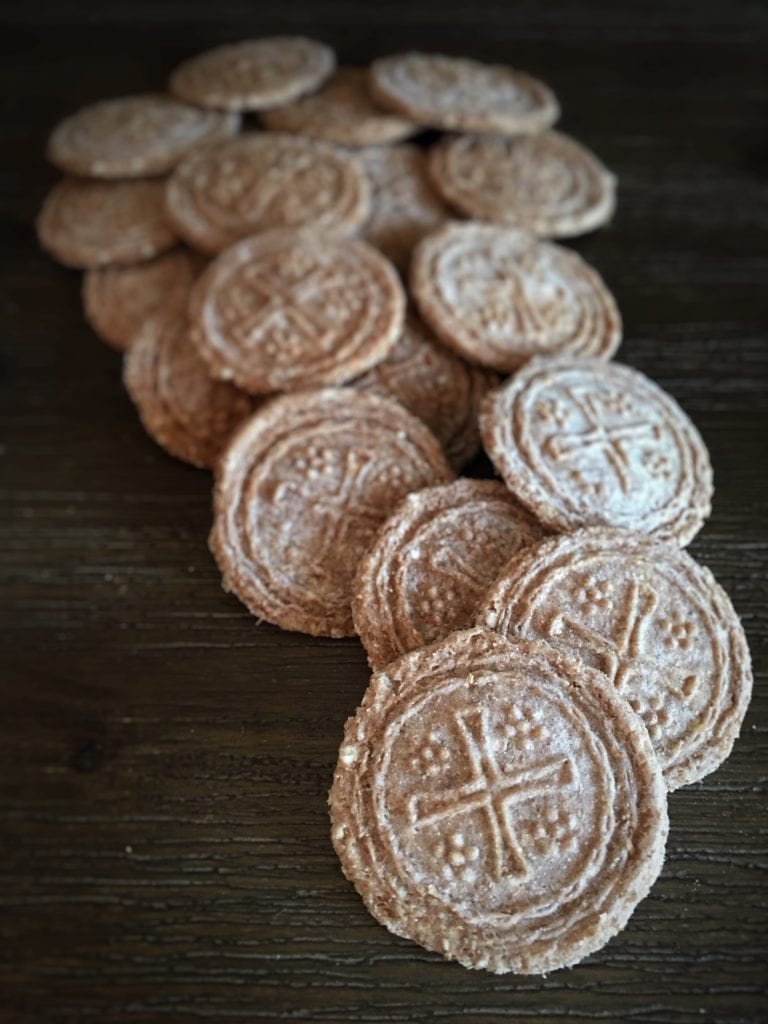
After you’ve made your offering to Fornax this week, you may wish to find a way to make use of the salt meal or wafers. I’m pretty sure that Fornax, much like her Roman subjects, did not approve of waste. She would want you to eat the remaining meal or wafers after you’ve paid your respects. If you made the meal, you can add some water and starter to it and make a loaf of bread. If you made the wafers, go ahead and eat them with cheese, moretum, soup, stew or lentils. But don’t forget to make your Mola Salsa offering soon… Fornax is waiting! Don’t be a fool and wait until the 17th!
Hail Fornax and good baking to you!
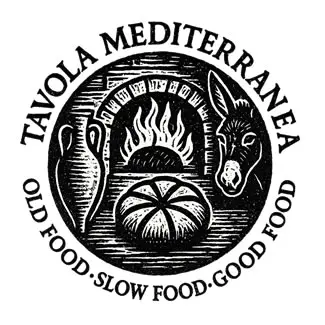
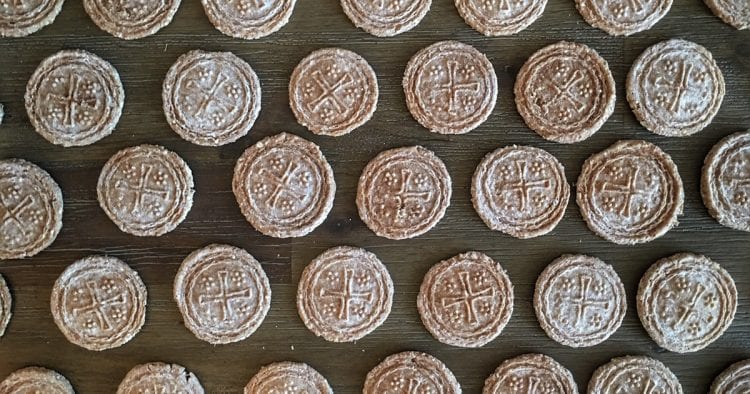




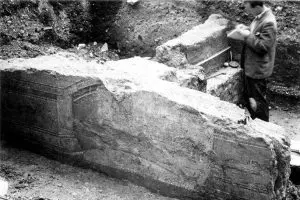


Very interesting! I love the Corzetti pattern. Where could I find one like it? Thank you.
So I’m trying this (as both an offering for Janus and for purification), and I got a hand-crank grain will for the purpose, since I found an inexpensive one and I don’t have a food processor. But the meal is coming out very coarse, much more so than your photo, and I’m wondering if it’s just the mill, or if I didn’t parch the grain enough. Any thoughts you have would be appreciated.
Greetings Farrell. Really love your site – have been reading your extracts for ?a number of years now. Thank you for the wonderful history and delicious recipes.
(My PhD and area of expertise is/was traditional systems of medicine and the use of food as medicine so some of the ancient techniques (a little bit) familiar. I also love the challenge of using whatever we can grow and grows wild on our farm and in the garden). not surprisingly a lot of the ‘weeds’ are Mediterranean and most are edible and useful. Nature provides if we give her a little care and respect.
Best Wishes
Marlene
Millbrook Valley Farm, South Australia
Could you use this as part of an offering to Janus? I did find your recipe by looking up offerings to give Janus and am planning on using this for that purpose I was just curious if you had any insight to this idea.
Hi! This is specifically for ovens but I don’t think Janus would mind. Look into libum as well. 🙂 – Farrell
Intriguing connection between the Mola Salsa wafer and the communion wafer. I believe there is more continuity than we realize between past and present foods & traditions. As always, your articles are fascinating.
Thank you Lisa!
Fascinating, thank you.
Thank you Julia!
Thank you for sharing this. I would love to see “taste” and Tradition return to the Eucharistic celebration of communion rather than tasteless wafers, so your photo drew me to your Mola Salsa photo lured me in. 🙂
please sing me up for your newslletter thank you from mr.kretzschmar
Wow, Awesome! Thanks for the effort, I learnt a lot and I will certainly try it!